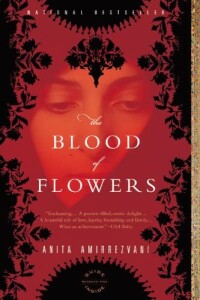 Toward the end of The Blood of Flowers, the unnamed narrator and main character says, “All our labors were in service of beauty, but sometimes it seemed as if every thread in a carpet had been dipped in the blood of flowers.” In her author’s note at the very end of the book, Anita Amirrezvani admits that this novel took her nine years and three trips to her native Iran to complete. I think it’s safe to say that this beautiful book was, like the carpets that are central to its plot, the product of considerable effort and personal sacrifice.
Toward the end of The Blood of Flowers, the unnamed narrator and main character says, “All our labors were in service of beauty, but sometimes it seemed as if every thread in a carpet had been dipped in the blood of flowers.” In her author’s note at the very end of the book, Anita Amirrezvani admits that this novel took her nine years and three trips to her native Iran to complete. I think it’s safe to say that this beautiful book was, like the carpets that are central to its plot, the product of considerable effort and personal sacrifice.
The Blood of Flowers takes place in the 1620s, primarily in the city of Isfahan, then the capital of Iran and a renowned center of carpet design and production. Our narrator is fourteen when the story begins, the only child of older parents living in a village south of the capital. After her father dies unexpectedly, she and her mother travel to Isfahan to live in the household of her father’s half brother Gostaham and his wife Gordiyeh. Gostaham has done well for himself, becoming an assistant master for color at a carpet workshop under the sponsorship of Shah Abbas (a real person who encouraged the development of Iranian carpet craft during his long reign).
Gostaham takes a liking to the girl, who has already demonstrated her ability to make carpets and expresses an eager desire to learn to design them, as well. But Gordiyeh treats the girl and her mother like servants, working them hard and expecting them to contribute to the household’s coffers at the same time. After a series of setbacks that are largely a consequence of the girl’s impulsiveness (I was impulsive as a teenager, weren’t you?), they are left with but one option for fulfilling the latter obligation, which is to enter the girl into a sigheh, a short-term, contractual “marriage” to a wealthy businessman that entails a fairly generous payment.
As the plot unfolds, the girl learns to read and write and starts to design her own carpets. She also loses her virginity and quite a lot of her innocence. Finally, after still more setbacks, some quite disastrous, she even learns to control her impulsiveness, a behavior I came to understand as a consequence of the many constraints imposed on her native intelligence. For this is a patriarchal society, one in which female children are typically expected to help with household chores, behave demurely, cultivate beauty, and eventually marry into a new household where they are expected to do the household chores (or oversee the servants), behave demurely, and bear children, preferably male children.
Although she follows the teachings of the Quran and wears both chador (head covering) and picheh (face veil) when she is in public, our narrator is far too ambitious and headstrong the fit the mold of the typical Iranian woman of her time. The novel is really about how she comes to terms with this, finding ways to be herself in a society that doesn’t fully accept women like her. The story ends on a hopeful note, when she is nineteen and thinking about a real marriage and family — as long as these responsibilities don’t preclude her carpet designing activities.
Amirrezvani has done a splendid job of using words to evoke the time and place. Her depictions of both the stunning and the squalid aspects of Isfahan are rich with sensuous details of color and sound and smell, as are her descriptions of the interiors of rooms, of people’s clothing, of carpets and food. I particularly enjoyed the scenes that took place in the city’s mosques, hammams (baths), and marketplaces.
Another narrative strategy that helps to ground this novel in a Middle Eastern sensibility is Amirrezvani’s use of embedded short stories, a technique many Western readers have encountered in The Arabian Nights. Amirrezvani uses seven such stories in The Blood of Flowers, clearly delineated by their italicized text and the opening statement: “First there wasn’t and then there was. Before God, no one was.” All but the first and last of these stories are retellings of traditional stories that Amirrezvani came across in her extensive preparatory research.
Although I see no evidence to suggest that Little, Brown is marketing this title to young adults, the age and experiences of its main character definitely recommend it to that group of readers, especially to young women. I also think that the publisher could have done a better job of packaging this novel. Sure, the dust jacket is gorgeous. But Amirrezvani’s descriptions of Isfahan and her main character’s travels around it would have been so much easier to follow if a simple line map of the city had been included, perhaps printed on the inside front cover pages. And there are a few places in the narrative that would have benefited from the addition of small corresponding illustrations, e.g. when her friend Naheed is teaching our narrator how to write and later when she begins to draw her own carpet designs.
But these are minor quibbles. This is a lovely debut novel, well worth reading and sharing. I can only hope that royalty payments from this product are sufficient to buy Amirrezvani time from her other employment to enable her to write another novel in something less than nine years!
(Little, Brown and Company, 2007)
